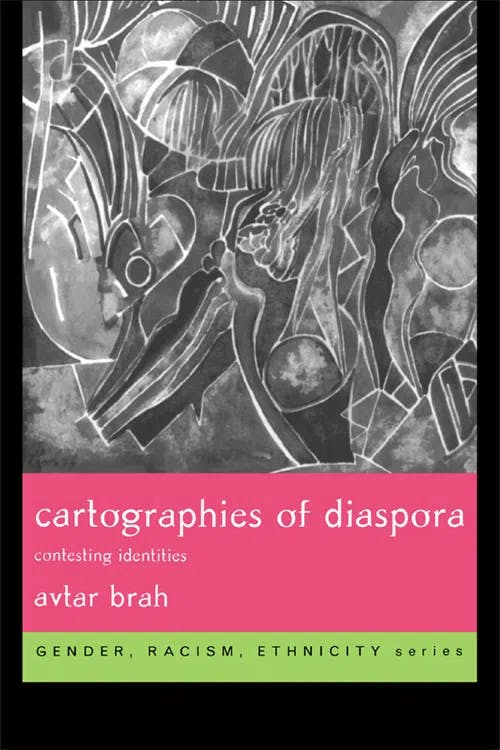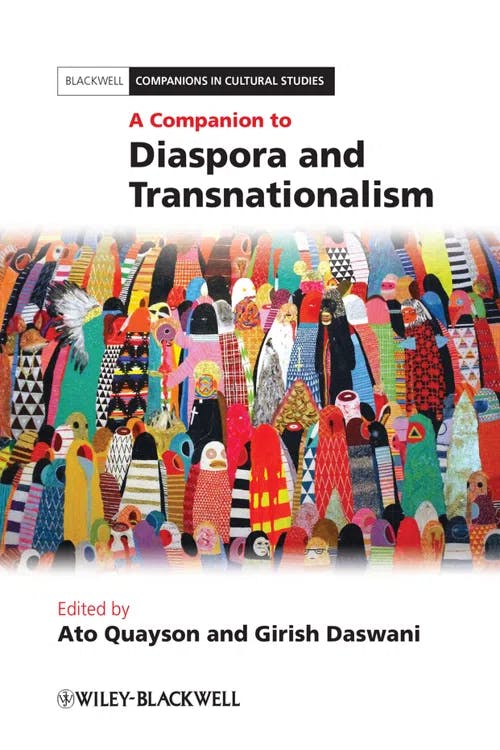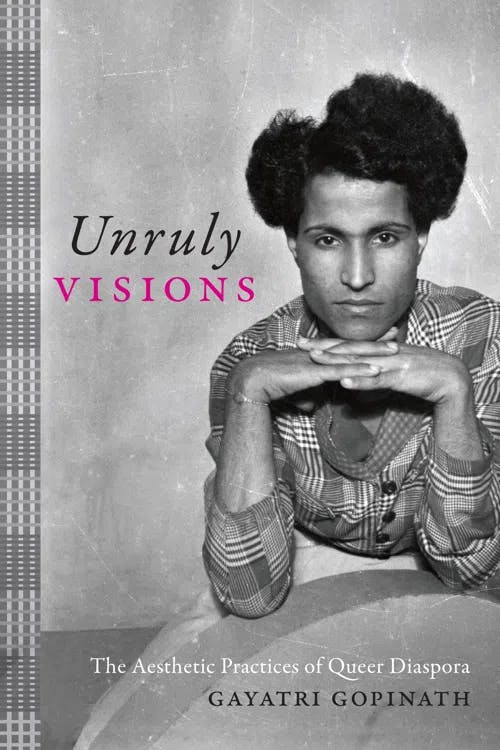What is Diaspora Theory?
MA, Gender Studies (London School of Economics & Political Science)
Date Published: 03.05.2023,
Last Updated: 19.07.2024
Share this article
Defining and categorizing diasporas
The concept of a diaspora is crucial to the field of migration studies and to the wider social sciences. How we define a diaspora is, itself, a site of contestation, but in starting with a broad definition we can begin to understand what diaspora theory encapsulates. In his chapter “An African Diaspora: The Ontological Project” in The African Diaspora: African Origins and New World Identities, Nigerian academic Michael J. C. Echeruo defines a diaspora as “a ‘nation in exile,’ a ‘race in exile,’ and a ‘people in exile,’ however vaguely we define ‘exile’ and irrespective of how long it lasts or can last” (2001). This definition invites us to consider how many different diasporas have existed and under what circumstances. Oftentimes, the term “diaspora” is used to refer to the Jewish diaspora, which resulted as a consequence of socioeconomic discrimination which forced Jews out of Palestine in the eighth century. However, a great number of diasporas have occurred and existed throughout history in a litany of different sociocultural contexts. In Global Diasporas: An Introduction, diaspora studies scholar Robin Cohen provides six main types of diasporas:
- Victim diasporas — the most common use of the term “diaspora” — are cultures forcibly exiled from homelands (e.g. Jewish, African, Armenian diasporas).
- Labor diasporas arise from movement in search of employment or work opportunities (e.g. indentured plantation workers from India, China, and Japan).
- Imperial diasporas result from colonial projects or migration for the sake of maintaining empires (e.g. British and Russian diasporas).
- Trade diasporas develop from migration motivated by creating trade links (e.g. Lebanese, Chinese diasporas).
- Deterritorialized diasporas do not share one specific homeland but rather share a cultural space (e.g. Caribbean peoples).
- Incipient diasporas are groups that seem likely to become diasporas (e.g. seemingly temporary workers engaged by the Gulf States and Germany after the Second World War).
For more on these categories, additional subcategories, and case studies, we recommend Global Diasporas: An Introduction and Migration and its Enemies, both by Cohen.
In these six types of diaspora, different themes emerge. In victim diasporas, one key theme is often racism or white supremacy. In imperial diasporas, colonialism presents an enduring challenge for those impacted by said diaspora, especially for those who hosted migrants from the colonial state. However, across all of these categories we see three key actors that make up the framework of diaspora theory, as Judith T. Shuval writes in “Diaspora Migration”:
Diaspora theory is structured around three principal actors — homeland, diaspora group, host — who interact in a multi-faceted, changing set of relationships which may be viewed on a bifocal or trifocal level. (2000)
Diaspora theory, as a research methodology, invites us to consider how these three principal actors interact. By analyzing the components that make up the homeland and host — such as their socioeconomic, cultural, and political climates — we can begin to understand how community develops when dispersed away from its point of origin.
It is important at this stage that we differentiate diaspora theory from transnationalism. As discussed in our “What is Transnationalism?” study guide, the concept of transnationalism is often used alongside diaspora theory. However, diaspora theory specifically emphasizes the experiences of people “exiled” from their homelands as opposed to the broader experience of migration. As stated by sociologist Thomas Faist:
Although both terms refer to cross-border processes, diaspora has been often used to denote religious or national groups living outside an (imagined) homeland, whereas transnationalism is often used both more narrowly — to refer to migrants’ durable ties across countries — and, more widely, to capture not only communities, but all sorts of social formations, such as transnationally active networks, groups and organisations. (“Diaspora and Transnationalism: What Kind of Dance Partners,” in Diaspora and Transnationalism: Concepts, Theories and Methods, 2010)
Diaspora theory has also been argued to be more political in nature: it contends with matters of inequality more directly than transnationalism, which focuses more on the phenomena of migration and less on the sociopolitical mechanisms behind it. Gender scholar and diaspora theorist Asale Angel-Ajani states that "there is the possibility within diaspora studies to move away from the politically sanitized discourse that surrounds transnational studies" (2006). Diaspora theory and transnationalism are interlinked and focus on similar mechanisms, but the exploration of how banishment or removal from one’s homeland impacts a community is not the same as investigating how identities are impacted by the crossing of geographical and cultural borders in any act of relocation.
How does diaspora theory relate to different fields of study?
As the diasporic experience can impact a host of factors in one’s lived experience, diaspora theory’s relevance encompasses multiple academic fields, not just migration studies. Notably, much writing on diaspora theory has been written by anthropologists and sociologists, but exile and displacement are issues which can also impact a country’s economic systems, international relations, and internal politics. Diasporas are not only a matter of cultural disruption but also a subject to be addressed from a socioeconomic standpoint.
Perhaps most crucially, diaspora theory is a subject of interest for scholars within colonial and postcolonial studies. Colonialism is the practice of one group of people occupying and controlling the country and land of another group of people, the impact of which is vast and multi-faceted. Colonialism is an exploitative and harmful practice which often leads to socioeconomic inequality for and discrimination against native communities, thus exiling native groups from their lands and forcing them to search for survival and safety elsewhere. We can see an example of how colonial and postcolonial studies are connected to diaspora theory in the following section.
Applying diaspora theory to real-world scenarios
In applying diaspora theory to history we can better understand the mechanisms underpinning acts of migration. A useful example emerges in Cartographies of Diaspora by sociologist Avtar Brah. Brah details the migration of South Asians to the United Kingdom in the 1950s and 1960s and what circumstances led to this occurrence:
Britain experienced severe labour shortages during the post-World War II period of economic expansion. At the same time, having been systematically exploited during the colonial period, Britain’s ex-colonies faced a future of poverty. They had a large labour force, but insufficient means to make this labour productive. Migration of labour from the ex-colonies to the metropolis during the 1950s was thus largely a direct result of the history of colonialism and imperialism of the previous centuries. If once the colonies had been a source of cheap raw materials, now they became a source of cheap labour. (2005)
Avtar Brah
Britain experienced severe labour shortages during the post-World War II period of economic expansion. At the same time, having been systematically exploited during the colonial period, Britain’s ex-colonies faced a future of poverty. They had a large labour force, but insufficient means to make this labour productive. Migration of labour from the ex-colonies to the metropolis during the 1950s was thus largely a direct result of the history of colonialism and imperialism of the previous centuries. If once the colonies had been a source of cheap raw materials, now they became a source of cheap labour. (2005)
Let’s break down this passage in terms of the three primary “actors” in diaspora theory: the homeland, the diaspora group, and the host.
With the homeland, we have established that colonialism impacted South Asian colonies severely, putting the residents of these countries in a position of significant socioeconomic disadvantage. With the diaspora group, we can see that their migration from homeland to host country is motivated by this socioeconomic disadvantage, forcing them to relocate in order to avoid poverty. With the host country, it is evident that the diaspora group was relocating to a country which already had ties of its own to the homeland — and would be more socioeconomically stable as a consequence of their exploitative colonizing practices.
While this act of migration may at first appear to have been voluntary, the depletion of resources in these South Asian countries by the United Kingdom left many South Asians with little choice but to leave behind their homelands to survive. Given the interplay of these factors, it seems reasonable to argue that colonization led to an exile of South Asians aiming to escape poverty. Here, diaspora theory is perhaps more suited than a transnationalist lens: diaspora theory assists us in differentiating between cross-border migration that was voluntary or optional and cross-border migration that was necessary or compelled.
Significant texts on diaspora theory
About this book
For academics new to the subject matter of migration studies, A Companion to Diaspora and Transnationalism, edited by Ato Quayson and Girish Daswani, is a highly valuable interdisciplinary exploration of diaspora theory and the concept of transnationalism. Quayson and Daswani bridge the divide between theory and practice with this collection of insightful case studies and multidisciplinary analyses. This text effectively introduces and explains key terminology in the migration studies field and utilizes it in examples both historical and contemporary.
Format ePUB (mobile friendly)
Year 2013
About this book
Diasporas: Concepts, Intersections, Identities, edited by Kim Knott and Seán McLoughlin, is the next port of call for any scholar looking to establish strong foundations in the field of migration studies or postcolonial research. Knott and McLoughlin’s book is split into three sections. The first provides comprehensive definitions for the terminology used throughout migration studies. The second then investigates the intersections of diaspora experience(s) with various protected characteristics and forms of media. The third is a collection of case studies and essays on a host of diasporas around the world. This publication is absolutely essential for academics outside of the field looking to build their knowledge of diaspora theory from the ground up.
Format ePUB (mobile friendly)
Year 2013
About this book
For those looking to expand their understanding of diaspora theory beyond a nation-centric lens, Unruly Visions: The Aesthetic Practices of Queer Diaspora by feminist scholar Gayatri Gopinath is a great place to start. Gopinath’s writing, which powerfully explores queerness from a postcolonial standpoint, challenges the misconception that diasporas occur solely when one ethnic group is exiled from one geographical location. Confronting the experience of queer exile and the patterns of dispersion that follow, Gopinath’s interdisciplinary and intersectional publication is an insightful and thought-provoking expansion on the original conception of the diaspora.
Format PDF
Year 2018
Diaspora theory is a gateway. Through it we are invited to consider how transnationalism, colonialism, displacement, persecution, and inequality shape the movement and safety of peoples all around the planet. By understanding the actors at play — the homeland, the diaspora group, the host — we can begin to interrogate the misconceptions normalized in the mainstream about identity, belonging, nations, states, and what it means to be a “native.” When we strive to better understand the impact of exile, displacement, and relocation on societies, our awareness of what constitutes a given culture or community becomes a richer and more informative tapestry. Diaspora theory is a theory that belongs to no academic discipline and stands to benefit scholars of the social sciences, literature, media, and beyond.
Further resources & reading on Perlego
Diaspora and Hybridity (2005) by Virinder Kalra, Raminder Kaur and John Hutnyk
Between Colonialism and Diaspora: Sikh Cultural Formations in an Imperial World (2006) by Tony Ballantyne
Routledge Handbook of the South Asian Diaspora (2014) edited by Joya Chatterji and David Washbrook
The African Diaspora Population in Britain: Migrant Identities and Experiences (2016) by Peter J. Aspinall and Martha J. Chinouya
Diasporas (2008) by Stephane Dufoix
British and Irish Diasporas: Societies, Cultures and Ideologies (2019) edited by Donald MacRaild, Tanja Bueltmann, and Jonathan Clark
Diasporas and Homeland Conflicts: A Comparative Perspective (2016) by Bahar Baser
Migration and its Enemies: Global Capital, Migrant Labour and the Nation-State (2016) by Robin Cohen
What is diaspora theory in simple terms?
What are the types of diaspora?
What is the difference between diaspora theory and transnationalism?
What are the best books on diaspora theory?
Bibliography
Angel-Ajani, A. (2006). “Displacing Diaspora: Trafficking, African Women, and Transnational Practices,” in Gomez, M. A. (ed.), Diasporic Africa. NYU Press, pp. 290-308.
Brah, A. (2005). Cartographies of Diaspora: Contesting Identities. Routledge. Available at: https://www.perlego.com/book/1604191/cartographies-of-diaspora-contesting-identities-pdf.
Cohen, R. (2022). Global Diasporas: An Introduction. Routledge. Available at: https://www.perlego.com/book/3518673/global-diasporas-an-introduction-pdf.
Echeruo, M. J. C. (2001). “An African Diaspora: The Ontological Project,” in Okpewho, I., Davies, C. B., and Mazrui, A. A. (eds.), The African Diaspora: African Origins and New World Identities, pp. 3-18.
Faist, T. (2010). “Diaspora and Transnationalism: What Kind of Dance Partners,” in Bauböck, R. and Faist, T. (eds.), Diaspora and Transnationalism: Concepts, Theories and Methods, Amsterdam University Press. pp. 9-34.
Gopinath, G. (2018). Unruly Visions: The Aesthetic Practices of Queer Diaspora. Duke University Press. Available at: https://www.perlego.com/book/1466221/unruly-visions-the-aesthetic-practices-of-queer-diaspora-pdf.
Knott, K., and McLoughlin, S. (eds.) (2013). Diasporas: Concepts, Intersections, Identities. Zed Books. Available at: https://www.perlego.com/book/2003102/diasporas-concepts-intersections-identities-pdf.
Quayson, A., and Daswani, G. (eds.). (2013). A Companion to Diaspora and Transnationalism. Wiley-Blackwell. Available at: https://www.perlego.com/book/999934/a-companion-to-diaspora-and-transnationalism-pdf.
Shuval, J. T. (2000). “Diaspora Migration: Definitional Ambiguities and a Theoretical Paradigm. International Migration, 38(5), pp. 41-56.
MA, Gender Studies (London School of Economics & Political Science)
Georgie Williams is a deferred doctoral student in the field of Social Justice at University College Dublin and founder of gender & sexuality research hub, /Queer. Georgie’s research predominantly focuses on the development of gender and sexuality related social practices in post-colonial countries and the application of reflexive feminist methodologies to anthropological and sociological field research.




